|
Chart of Strategic
Nuclear Bombs |
| This chart describes all of the
Strategic Nuclear Bombs designed to be carried by aircraft. It
does not include those carried by the various missiles, nor the many
nuclear shells designed for use by army artillery. |
|
|

|
| Mk-1 |
| Yield:
|
15-16
Kt |
| Fusing: |
Airburst |
| Number
Produced: |
5 |
| Weight: |
8,900
lbs |
| Dimensions: |
28"
x 120" |
|
|
|
| The "Little Boy, " the atomic bomb dropped on Hiroshima. It was a
gun-assembly HEU bomb. Never stockpiled, only five
assemblies were completed. They were retired by November 1950 |
|
|
|
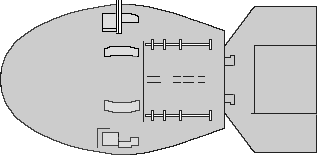
|
| Mk-3 |
| Yield:
|
18-49
Kt |
| Fusing: |
Airburst |
| Number
Produced: |
120 |
| Weight: |
10,300
lbs. |
| Dimensions: |
60"
x 128" |
|
|
|
| This is the "Fat Man" atomic bomb, dropped on Nagasaki,
Japan. It was a Plutonium implosion bomb. The basic
design was modified and upgraded over the next ten years. 120 were
produced between April 1947 and April 1949. They were all
retired in late 1950 |
|
|
|
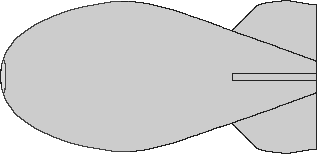
|
| Mk-4 |
| Yield:
|
1-32
Kt |
| Fusing: |
Airburst |
| Number
Produced: |
550 |
| Weight: |
10,800-10,900
lbs. |
| Dimensions: |
60"
x 128" |
|
|
|
| The Mark 4 was a redesign of the "Fat Man." It was the
first assembly-line produced nuclear bomb. It could be configured
to for various yields - 1, 3.5, 8, 14, 21, 22, and 31
kilotons. |
|
|
|
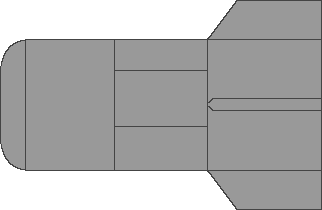
|
| Mk-5 |
| Yield:
|
6-120
Kt |
| Fusing: |
Airburst
or Contact |
| Number
Produced: |
140 |
| Weight: |
3,025-3,125
lbs. |
| Dimensions: |
43.75"
x 129" or 132" |
|
|
|
| The Mark 5 represented a major breakthrough in nuclear bomb
design. This high efficiency implosion bomb could be configured to
yield three times the explosive power of the Fat Man. Although it
was about the same length, it had a thinner body. Equally, if not
more important, it weighed less than a third of the fat man. It
was later used as the primary, or first stage, in the first thermonuclear
devices. It could be used in to yield 6, 16, 55, 60, 100, or 120
kilotons. It entered the operational stockpile in June 1952.
The last one was retired in January of 1963. |
|
|
|
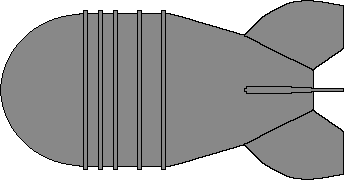
|
| Mk-6 |
| Yield:
|
8-160
Kt |
| Fusing: |
Airburst
or Contact |
| Number
Produced: |
1,100 |
| Weight: |
7,600-8,500
lbs. |
| Dimensions: |
61"
x 128" |
|
|
|
| The Mark 6 was an improved high-yield and lightweight Mk-4.
Could be configured to yield, 8, 26, 80, 154, or 160 kilotons. It
was produced from June 1951 through early 1955. It was retired in
1962. |
|
|

|
|
|
The Mk-7 "Thor" was light-weight, multipurpose
tactical bomb. The 92 lens
implosion system permitted yields of 8, 19, 22, 30, 31, and 61
kilotons. Over 1,700 were produced between July 1952 and February
1963. They were in service from July until 1967. |
| Mk-7 |
| Yield:
|
8-61
Kt |
| Fusing: |
Airburst
or Contact |
| Number
Produced: |
1,700
- 1,800 |
| Weight: |
1,645-1,700
lbs. |
| Dimensions: |
61"
x 128" |
|
|
|
|
|
|

|
| Mk-8 |
| Yield:
|
25-30
Kt |
| Fusing: |
Pyrotechnic
Delay |
| Number
Produced: |
40 |
| Weight: |
3,230-3,280
lbs. |
| Dimensions: |
14.5"
x 116" or 132" |
|
|
|
| Nicknamed, "Elsie", the Mark 8 was the first gun-assembly HEU bomb produced since the "Little Boy." It was
designed as an earth-penetration weapon that could be used against
hardened targets, such as underground command posts. Forty were
produced between November 1951 and May, 1953. It was retired in
June, 1957, replaced by the Mk-11. |
|
|
|

|
| Mk-11 |
| Yield:
|
25-30
Kt |
| Fusing: |
Pyrotechnic
Delay |
| Number
Produced: |
40 |
| Weight: |
3,210-3,500
lbs. |
| Dimensions: |
14"
x 147" |
|
|
|
| The Mark 11 was an improved version of the Mk8. There were not
many targets requiring its unique capabilities, thus production was
limited to replacing the Mk 8 on a one-for-one basis. They were
produced in 1956 and 1957 and remained in service until 1960,.
They were then stockpiled at the "Mk-91 Penetration
Bomb." |
|
|
|

|
| Mk-12 |
| Yield:
|
12-14
Kt |
| Fusing: |
Timer
or Contact |
| Number
Produced: |
250 |
| Weight: |
1,00-1,200
lbs. |
| Dimensions: |
22"
x 155" |
|
|
|
| Known as the "Brock," the Mark 12 was a light-weight nuclear
weapon designed to carried by fighters and fighter-bombers. It was
probably the first nuclear weapon to use beryllium tamper . 250
were produced between December 1954 and February 1957. They were
retired in July, 1958. |
|
|
|

|
|
The Mark 14 was the first deployed solid-fuel thermonuclear
weapon. Only five were made. They were recycled into the Mk-17
weapons by September of 1956. Carried a 64 foot parachute, thus fins
were not thought necessary. |
| Mk-14 |
| Yield:
|
5-7
Mt |
| Fusing: |
Airburst |
| Number
Produced: |
5 |
| Weight: |
28,954-31,000
lbs. |
| Dimensions: |
61.4"
x 222" or 223.5' |
|
|
|
|
|
|

|
| Mk-15 |
| Yield:
|
1.6-3.9
Mt |
| Fusing: |
Airburst |
| Number
Produced: |
1,500 |
| Weight: |
7,600
lbs. |
| Dimensions: |
34.4"
x 140" |
|
|
|
| The Mark 15 was the first "lightweight" U.S. TN bomb. Denotation
was delayed through the use of three parachutes. It used HEU secondary casing; 3
mod3s. |
|
|
|

|
|
The Mark 16 was the first deployed thermonuclear
weapon.
It was the red version of Ivy Mike device. It was
the only cryogenic TN weapon ever deployed. The were stockpiled
for only three months, January thru April, 1954. |
| Mk-16 |
| Yield:
|
6-8
Mt |
| Fusing: |
Airburst |
| Number
Produced: |
5 |
| Weight: |
39,000-42,000
lbs. |
| Dimensions: |
61.4"
x 296.7" |
|
|
|
|
|
|

|
|
Weighing in at over ten tons, the Mark 17 was the
heaviest U.S. nuclear weapon ever built. It could only be carried
by the
B-52. It also had the second highest yield of any U.S.
weapon. It was deployed using a single 64-foot parachute.
The delay in fall gave the aircraft additional time to escape the
blast. Two hundred were produced between July 1954, and
November 1955. All retired in November of 1956. |
| Mk-17 |
| Yield:
|
10-15
Mt |
| Fusing: |
Airburst
or Contact |
| Number
Produced: |
200 |
| Weight: |
41,400-42,000
lbs. |
| Dimensions: |
61.4"
x 296.7" |
|
|
|
|
|
|

|
| Mk-18 |
| Yield:
|
500
Kt |
| Fusing: |
Airburst
or Contact |
| Number
Produced: |
90 |
| Weight: |
8,600
lbs. |
| Dimensions: |
60"
x 128" |
|
|
|
| Known by the acronym, "SOB" (Super Oralloy Bomb), the Mark
18 was a super-updated version of the old "Fat Man" design
that produced a much higher yield than earlier models. It was
essentially a re-engineered Mark 6. It produced the greatest yield
of any pure fission bomb ever deployed. 90 were produced between
March 1953 and February, 1955. They were retired in 1956 by going
back to the lower yield Mark 6. They were superceded by the
Mk 16 and Mk 28. |
|
|
|
The Mark 21 was a redesigned Shrimp TN device with 95% enriched Li-6.
Three models, all were "dirty." The "clean"
version was never tested. Although 275 were produced between
December 1955 and July 1956, they were never deployed. During the
second half of 1957, they were retired by converting them into Mk-36s. |
| Mk-21 |
| Yield:
|
4-5
Mt |
| Fusing: |
Airburst,
Contact
and Laydown |
| Number
Produced: |
275 |
| Weight: |
15,000-17,700
lbs. |
| Dimensions: |
58"
x 150" |
|
|
|
|
|
|
The Mark 24 was identical in appearance to the Mk-17
(see above), but had a different secondary. It was heaviest U.S. nuclear weapon,
2nd highest yield of any U.S. weapon (along with similar Mk-17). 105
were produced between July 1954 and November, 1955. Retired in
1956. |
| Mk-24 |
| Yield:
|
10-15
Mt |
| Fusing: |
Airburst
or Contact |
| Number
Produced: |
105 |
| Weight: |
41,400-42,000
lbs. |
| Dimensions: |
61.4"
x 296.7" |
|
|
|
|
|
|
|
|
The Mark 28 was SAC's primary Cold War weapon for many
years. Production began in January, 1958, but a problem was
discovered with the safety mechanism that resulted in five month
delay. It was corrected and production continued through May,
1966. The Mk-28 was a highly dependable multipurpose
tactical and strategic bomb carried by virtually all SAC's
bombers. It was in service thirty-three years: from 1958 until
retired in 1991. |
| Mk-28 |
| Yield:
|
70
Kt - 1.1 Mt |
| Fusing: |
Airburst
or Contact |
| Number
Produced: |
4,500 |
| Weight: |
1,700-2,320
lbs. |
| Dimensions: |
22"
x 170" |
|
|
|
|
|
|
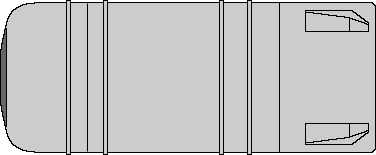
|
| Mk-36 |
| Yield:
|
9-10
Mt |
| Fusing: |
Airburst, Contact
and retarded |
| Number
Produced: |
940 |
| Weight: |
17,500-17,700
lbs. |
| Dimensions: |
58"
x 150" |
|
|
|
| The Mark 36 was a two-stage TN strategic bomb. Between April
1956 and June 1958, a whooping 940 were produced. 275 of them were
converted Mk-21s. Widely carried by SAC aircraft, it represented
half of the U.S. megatonnage at the time of it's retirement in August,
1961. There were two versions, the Y1 "dirty" version
and the Y2 "clean." Because of the extreme power
of it's blast, it utilized two parachutes to slow it's
descent. This allowed the aircraft more time to escape. |
|
|
|

|
| Mk-39 |
| Yield:
|
3-4
Mt |
| Fusing: |
Airburst, Contact
and retarded Laydown. |
| Number
Produced: |
700 |
| Weight: |
6,650-6,750
lbs. |
| Dimensions: |
35"
x 140" |
|
|
|
| The Mark 39 was an Improved Mk-15. It used a gas-boosted primary
to reduce weight; thermal batteries, and had improved safeties. The
new plain and finless casing caused it be referred to as the "trash
can." Two models were produced between February 1957
and March 1959. One yielded 3 megatons, the other four. Two
parachutes delayed detonation. Retired between 1962 and
1966. |
|
|
|
Yielding a 25 megaton blast, the Mark 41 was the most
powerful U.S. weapon ever deployed. It was a three stage TNT
weapon. Two versions were produced, one "clean" and one
"dirty." Two parachutes delayed detonation. 500
were produced between September 1960 and June 1962. They remained
in service for many years. The last one was retired in July
1976. |
| Mk-41 |
| Yield:
|
25
Mt |
| Fusing: |
Retarded
Airburst, Contact and Laydown |
| Number
Produced: |
500 |
| Weight: |
10,500-10,670
lbs. |
| Dimensions: |
52"
x 148" |
|
|
|
|
|
|
|
|
The Mark 43 was basically a laydown bomb for high-speed low-altitude
delivery. Five models yielding 70 Kt, 500 Kt and 1 Mt. Model
4 was fission only. Two parachutes. They were produced
between April 1961 and October, 1965. In lated 1972, the U.S.
began phasing them out of active deployment, but the last one was not
retired until April of 1991. |
| Mk-43 |
| Yield:
|
70
Kt - 1 Mt |
| Fusing: |
Retarded
Airburst, Contact and Laydown |
| Number
Produced: |
1,000 |
| Weight: |
2,060-2,125
lbs. |
| Dimensions: |
18"
x 150" or 164" |
|
|
|
|
|
|
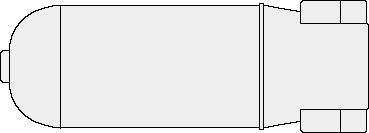
|
| Mk-53 |
| Yield:
|
9
Mt |
| Fusing: |
Retarded
Airburst, and Contact Laydown. |
| Number
Produced: |
350 |
| Weight: |
8,850-8,900
lbs. |
| Dimensions: |
50"
x 150" |
|
|
|
| The Mark 53 was carried by B-47, B-52; and B-58 bombers. Two
models were produced between August 1962 and June 1965,
"clean" and "dirty." The Y2 "clean" fissile material
was all HEU, no plutonium. Three parachutes. SAC began
retiring the early models in July 1967, but they remained in permanent
stockpile until early 1997. 50 are still in stockpiles. |
|
|
|
The Mark 57 was a light-weight multipurpose tactical
strike and depth bomb made in six models. They were produced
between January 1963 and May 1967. Retired in June 1993 in favor
of the the B-61. |
| Mk-57 |
| Yield:
|
5-20
Kt |
| Fusing: |
Retarded
Airburst, Contact and Laydown |
| Number
Produced: |
3,100 |
| Weight: |
490-510
lbs. |
| Dimensions: |
14.75"
x 118" |
|
|
|
|
|
|

|
| Mk-61 |
| Yield:
|
80-340
Kt |
| Fusing: |
Retarded
Airburst, Contact and Laydown |
| Number
Produced: |
3,150 |
| Weight: |
695-716
lbs. |
| Dimensions: |
13.3"
x 141" |
|
|
|
| The Mark 61 was produced between October, 1966 and the early
1990's. It is a multipurpose tactical and /strategic bomb.
It's basic design has been adapted to many
other weapon systems. Four different yield configurations.
Single parachute. It enjoyed the longer production run of any
United States nuclear weapon and is the oldest design now in
service. 3,150 were produced, but early models were retired in the
1970's. Later models were retired in the 1980's. In 1997,
there were about 1,350 in service. |
|
|
|

|
| Mk-83 |
| Yield:
|
Low
Kt to 1.2 Kt |
| Fusing: |
Retarded
Airburst, and Contact Laydown. |
| Number
Produced: |
650 |
| Weight: |
2,400
lbs. |
| Dimensions: |
18"
x 145" |
|
|
|
| The Mark 83 is the current high-yield strategic TN bomb. 650
were produced between June, 1983 and 1991. In 1997, all were in
service. |
|
|
